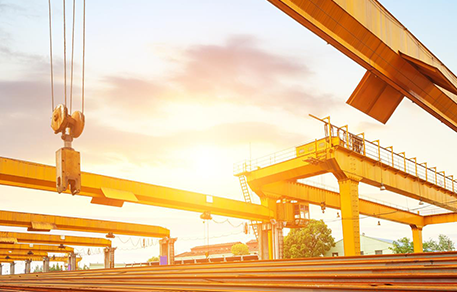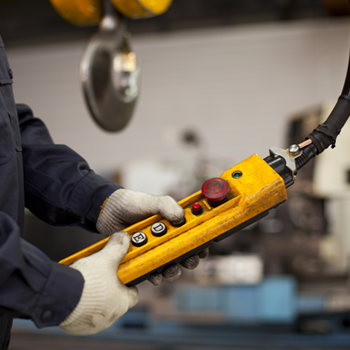With a range of crane service providers offering different services, it can be difficult to know what legal requirements you need in order to correctly and professionally use your overhead cranes.
Whether they offer LOLER examinations, PUWER inspections, or something in between, ultimately in order to run a safe workplace, you are required to have a range of services and tests carried out on your cranes, as well as all workplace equipment.
Lifting Operations and Lifting Equipment Regulations, otherwise known as LOLER, fall under the Health and Safety at Work etc. Act 1974 to ensure that all lifting equipment, including cranes, are being used in a safe manner. These regulations state that in order to be safe all operations must be planned by a ‘competent person’, and have regular examinations to ensure that their machinery is fit for purpose.
The LOLER Approved Code of Practice and Guidance states that the person carrying out an a examination should have the “appropriate practical and theoretical knowledge and experience of lifting equipment” to be able to thoroughly examine them. Although this person may be employed by another organisation, it is not necessary as long as they are impartial and able to detect defects or weaknesses in your crane. This also means that the person who undertakes the equipment’s routine maintenance should not undertake this assessment as, although they have the knowledge, they will be judging the quality of their own work and will be biased.
LOLER inspections are not the same as routine maintenance both should be carried out to ensure that your machinery is working appropriately.
Before any lifting operation, LOLER requires that the appropriate checks within the workplace are identified, noting any possible risks, and trying to ensure that you are able to carry out your tasks in a safe manner.
According to HSE, you must consider the following factors:
In order to ensure the safety of both yourself and your team, equipment that lifts people and or all lifting accessories must undergo LOLER checks every 6 months. Any other form of lifting equipment needs to be checked every 12 months.
You must keep records of all examinations and inspections that your crane and accessories have gone through, detailing any defects and what you must do in order to fix them. While records of all lifting equipment should be kept until the employer ceases to use them, lifting accessories should be kept up to two years.
The Provision and Use of Work Equipment Regulations 1998, or PUWER, requires that all work equipment provided for use is suitable, safe, and only used by those who have received training.
Work equipment is defined by HSE as ‘any machinery, appliance, apparatus, tool or installation for use at work.’ This not only covers any on-site machinery, but also any equipment employees bring into the workplace themselves, so the expectation of what constitutes ‘work equipment’ varies.

When dealing with worksite safety, PUWER dictates that you must ensure that your crane:
And, when bringing a new crane on site, it is vital that you check that it:
By ensuring that everyone operating the crane is well-trained and operating it safely, is not only for the protection of all surrounding staff but also the worker controlling it.
Whilst complying with LOLER and PUWER you should only see these as starting points to workplace safety. In order to ensure that your cranes are working both efficiently and safely, you should go beyond these regulations to minimise both the risk to your employees and your company’s liability.
Since the Health & Safety at Work Act 1974 (HSWA) as an employer or site manager, you have a duty of care that goes beyond the previously mentioned checklists. You need to eliminate risks to health and safety by putting plans in place to reduce them.
As the overhead crane can be extremely dangerous, LOLER and PUWER ensure that your workers are as safe as possible by providing information, instructions, training, or supervision. While these are the requirements, they should be treated as a base point for crane health and safety.
While you might think the previously mentioned checklists ensure workers safety, common injuries in crane accident claims are still made, and typically involve:
Not only would this injure your employee, but would also financially damage your company. Paying for a court case, downtime in between the trial, and financial compensation for your employee would cost far more than prevention.

Ultimately, in order to ensure you’re not legally liable for any health & safety issues in the workplace, it is best practice to use a crane services provider. Unbiased and with health & safety in mind, they would be able to carry out any regular maintenance on your cranes, go through any necessary training with workers, and perform servicing on your behalf.
Even if you are doing the bare minimum checks and regulatory examinations, this does not and will not guarantee your workers safety. Not only would this cause them a great deal of damage, but also to your company.
While you can carry out both LOLER and PUWER checks internally, in order to ensure that they are impartial, it is best to work with a crane service provider, such as Lloyds British. Offering well-rounded, vigorous health & safety procedures, employing an independent crane service provider could not only be best for your workers but best for you.
Get our expert knowledge delivered straight to your inbox, and keep up-to-date with the latest goings on in your industry.
Falls from a height continue to be the most common kind of fatal injury in the workplace for the 4th year running - with 171 fatal injuries from 2016-2021 being due to falls from a height. You may be ...
In 2005, the Work at Height Regulations (2005) were introduced to ensure the safety of those who work at potentially dangerous heights and they are still in place today. What does all this legal jargo...
According to HSE, you should be taking vital steps to protect your team when working at height. One way to minimise the likelihood of an accident is through the use of a Fall Arrest System.